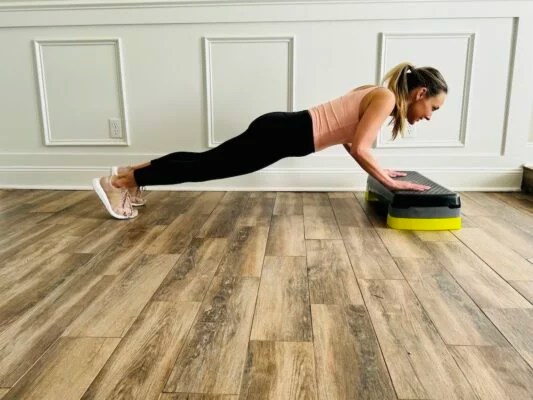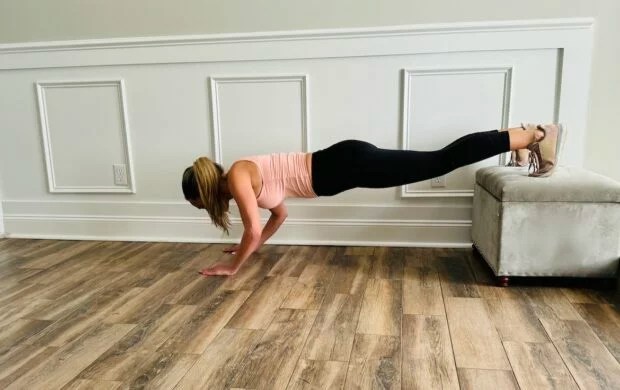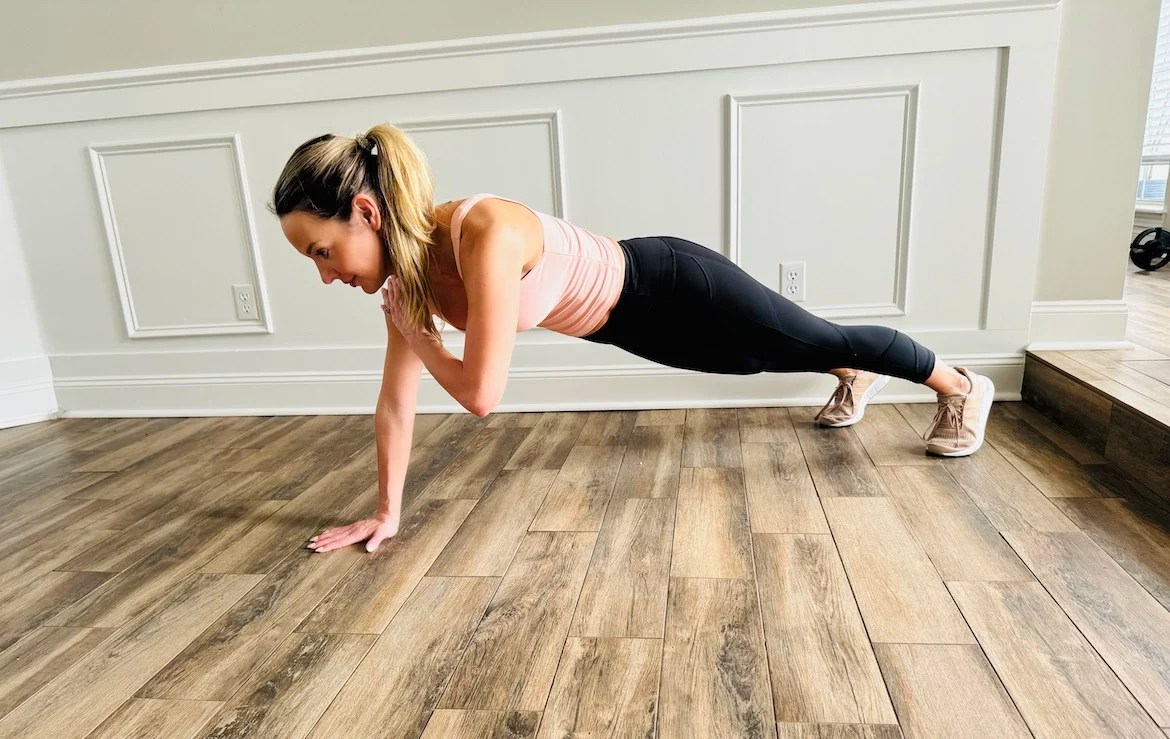The push-up is a well-known exercise, but its effectiveness and versatility may surprise you. Besides strengthening and toning your arms and chest, push-ups can also lower your risk of heart attack or stroke. But you won’t get the full-body benefits if you’re not using correct push-up form.
“Push-ups help improve upper-body strength, improve core stability, contribute to bone health, boost metabolism, reduce the risk of cardiac events, and can improve body composition,” says Karly Mendez, trainer and human performance specialist with Memorial Hermann’s Rockets Sports Medicine Institute.
Ready to reap all of these benefits? Let’s take a closer look at the muscles worked, correct push-up form, and some fun variations to try out.
Which muscles do push-ups work?
Many people only think about the push-up working the arms, but it strengthens your whole body.
Chest
Push-ups strengthen and build up the pectoral muscles (pectoralis major and minor), which are the large muscles at the front of your chest. These muscles essentially work throughout the entire push-up, as they work to lower you to the floor and assist in bringing you back up.
Arms, shoulders, and back
“Push-ups not only work the chest, but they also work the triceps and anterior deltoids,” says Mendez. In addition to your arms, they also strengthen the serratus anterior, which is a muscle that moves your shoulder blade and shoulder. You can focus on different muscles by switching up your hand placement during the push-up.
Abdominal muscles
Because you are in a plank position while doing a push-up, you are also strengthening your core, specifically your rectus abdominis, transverse abdominis, and the muscles on the side of your trunk, the obliques. The deep core muscles in your back, the erector spinae, are also working to keep your back stable and straight.
What correct push-up form looks like
There are many variations of the push-up, but it is important to first master the traditional push-up form.
- Start in a high plank position, with your hands shoulder-width apart, with your middle finger pointing forward. Your body should be in a straight line.
- Keeping your head aligned with your back, bend your elbows and lower yourself down toward the floor.
- Keep your elbows pointed back toward your hips, not flared or straight out.
- Try to lower down until you almost touch the ground (or go as far as you can go without sagging your hips or flaring your elbows).
- Press upward until your arms are fully straight and you are in the starting position.
- Repeat 2 sets of 10.
There is also the military-style hand-release push-up, which is also considered a traditional push-up, however the arms are moved out to the side between reps.
5 impressive push-up benefits
Need some motivation to include push-ups into your workout routine? Here are five reasons why this exercise should be at the top of your list.
1. Strengthens your upper body and core
The push-up works several large muscle groups at once, making it a quick and effective strengthening move. It builds strength and tones the muscles in your arms, shoulders, and core. This helps you not only do daily activities with greater ease, but strengthening these muscles also improves sports performance.
2. Improves heart health
As it turns out, you can push your way to a healthy heart! A 2019 study found that men who could do 40 push-ups had a 96% lower risk of having cardiovascular diseases (such as stroke or heart attack) over the next 10 years when compared to those who could only do ten or fewer push-ups.
3. Boosts metabolism and improves body composition
For those looking to change their body comp, make sure you’re doing push-ups. Experts say that because they work multiple large muscle groups at once, push-ups get your heart pumping and increase your metabolic rate.
A 2017 study found that doing resistance exercises (like push-ups) along with aerobic exercise and a healthy diet helps you gain muscle mass without losing bone density. This leads us to the next benefit….
4. Strengthens bones
Resistance exercises, including bodyweight exercises like push-ups, help to strengthen your bones, prevent fractures, and reduce your risk of osteoporosis. This is especially important as you get older.
5. Accessible and versatile
Push-ups can be done anywhere and they don’t require any special equipment, so they’re great to knock out a few throughout the day! This versatile exercise can be done by itself as a strengthening move, or as part of a high-intensity interval training (HIIT) circuit. You can also easily modify push-ups, making them more accessible or more difficult.
4 push-up variations to try
1. Incline push-up
If you are struggling to perform correct push-up form, there are several ways to make push-ups easier, such as doing them on your knees instead of in a plank position. Mendez recommends the incline push-up. By using an incline or a step, your body doesn’t have to fight gravity as much so you can focus on your form and build up strength.

- Place your hands on an incline or elevated surface, such as a stair step, bench, chair, or plyometric box.
- Your hands should be shoulder-width apart, with your legs straight behind you.
- Bend your elbows to lower yourself down until you have almost reached the incline surface, and then push yourself back up.
- Focus on pointing your elbows back toward your hips, versus straight out.
- Keep your head in alignment with your body.
- Repeat 2 sets of 10.
2. Decline push-up
Once you can do traditional push-ups with ease, it is time to challenge yourself with the elevated push-up. This move will strengthen your shoulders and pecs more than a traditional push-up. (If you want to focus on your biceps, try the pseudo planche push-up).

- Place your feet on an incline or elevated surface, such as a stair step, bench, chair, or plyometric box.
- Your hands should be shoulder-width apart on the floor, with your legs straight behind you on the elevated surface.
- Bend your elbows to lower yourself down until you have almost reached the floor, and then push yourself back up.
- Your elbows will want to move out, but focus on pointing them back toward your hips.
- Keep your head in alignment with your body.
- Repeat 2 sets of 10.
3. Shoulder tap push-up
This advanced push-up move not only targets the upper body, but it works the core more than a standard push-up. Make sure you are keeping your trunk stable by contracting your abs throughout the entire motion.

- Start in a standard push-up position, in a high plank with your hands shoulder-width apart.
- Keeping your head aligned with your back, lower yourself down toward the floor.
- Keep your elbows pointed back toward your hips versus straight out.
- Lower down until you almost touch the ground, or go as far as you can with proper form.
- Press upward until your arms are fully straight.
- Once you reach the top, take one hand and tap it on the opposite shoulder before placing it down on the ground.
- Next, touch the other shoulder with the opposite hand. This is 1 rep.
- Don’t let your body sway. Keep your core tight and stable.
- Lower back down and repeat the sequence.
- Repeat 1 to 2 sets of 8 to 10.
4. Diamond push-up

The narrow hand placement of the diamond push-up works your triceps much more than a standard push-up. If you’re ready to focus on your arm strength, give this variation a try.
- Place your hands in a diamond position on the floor, with your thumbs and index fingers touching.
- Keeping your hands in place, get into a plank position, with your arms straight and your feet straight behind you.
- Your hands will be in a diamond position under your chest, while your shoulders will be slightly in front of your hands.
- Bend your elbows and lower yourself down until your hands touch your chest.
- Keep your elbows close to your ribcage and avoid letting them flare out.
- Press up until your elbows are straight back in the starting position.
- Repeat 2 sets of 2 to 10 reps.
Common push-up form mistakes
Correct push-up form is important to not only get the full benefit of the exercise but to also avoid injuries. If you have had any shoulder, elbow, or hand injuries, talk to your doctor before doing this exercise. If you have wrist pain, you can also do the push-ups on dumbbells so your hands and wrist are in a more neutral position.
Here are the four most common push-up form mistakes—and how to fix them.
- Not going through the full push-up motion: Mendez says that not taking the push-up through its full range of motion doesn’t allow you to reap the full benefits. Make sure you go all the way down until your body almost touches the ground – and then make sure your arms reach full extension at the top. If you can’t do that, switch to knee push-ups or incline push-ups until you have built up more strength.
- Elbow position: Pay attention to your elbow position. Mendez says your elbows should not flare out or point outward. “Your elbows should angle back towards the hip,” she says. If you are doing a push-up variation, such as the diamond push-up, keep your elbows close to your rib cage and don’t let them point out at all.
- Hip position: While in the plank position for a push-up, your hips should be in a straight line. According to Mendez, if your hips are too high or sagging down to low, you aren’t using your core. Think about keeping your torso stiff and tight throughout the push-up.
- Hand position: Unless you are doing a push-up variation (like the diamond push-up), your hands should be shoulder-width apart and under your shoulders. Don’t let them go in front of your shoulders or place them too far apart as it could put too much stress on your shoulder joint.
FAQ
How many push-ups should you do a day?
“It is not necessary to perform push-ups every day, however, a modest amount is usually deemed to be okay,” says Mendez. You can do push-ups every day, but decrease the frequency if you are having any muscle or joint pain. Experts say you should, at a minimum, do resistance training (such as push-ups) two to three times a week.
As far as how many to do, Mendez says to work your way up with more sets as your strength improves. “If you can perform more than 25 push-ups, try implementing 2 to 3 sets of 10 to 25 repetitions,” she says.
For specific numbers, the American College of Sports Medicine has a fitness self-assessment chart that is broken down by age. For example, if you are a woman between the ages of 30 and 39 and you can do more than 39 push-ups, then that is considered excellent. For a man within the same age range, doing more than 44 push-ups is excellent.
Is it better to do push-ups fast or slow?
It depends on your goal. In general, you should do push-ups at a moderate and controlled pace, which is 2 seconds up and 2 seconds down. If you want to give your muscles more of a strengthening workout, you can slow it down. If you want more of a cardio or aerobic exercise, you can speed it up. Regardless of speed, make sure you keep your form intact.
Well+Good articles reference scientific, reliable, recent, robust studies to back up the information we share. You can trust us along your wellness journey.
- Yang J, Christophi CA, Farioli A, et al. Association Between Push-up Exercise Capacity and Future Cardiovascular Events Among Active Adult Men. JAMA Netw Open. 2019;2(2):e188341. doi:10.1001/jamanetworkopen.2018.8341
- Villareal, Dennis T et al. “Aerobic or Resistance Exercise, or Both, in Dieting Obese Older Adults.” The New England journal of medicine vol. 376,20 (2017): 1943-1955. doi:10.1056/NEJMoa1616338
